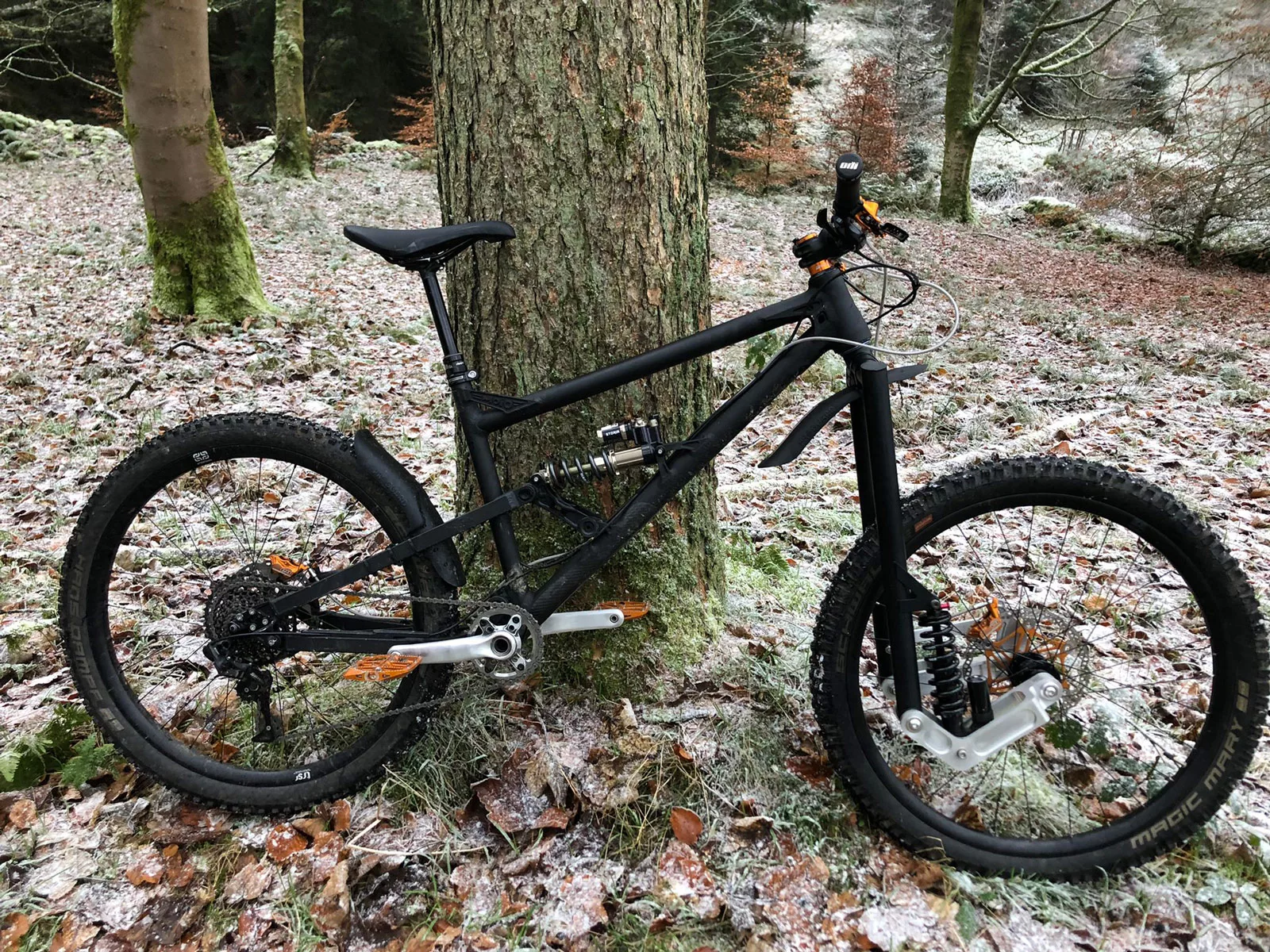Ashley Kalym, Founder of Rock Sled Suspension, gives us some insight into the what, how, and why of the long-travel fork he has been developing over the last 3-4 years. Ashley believes he has overcome the limitations of a traditional telescopic mountain bike fork design, namely the stiction and binding issues, with a leading-linkage fork design that uses an off-the-shelf-rear shock to damp impacts.
Rock Sled Suspension Leading Linkage Fork
Though uncommon, linkage forks are nothing new in the world of mountain biking. Trust Performance’s Shout and The Message multi-link forks did gain some traction for a short period of time, but the big brand suspension manufacturers have stayed away from the design, choosing instead to refine the damping systems of their traditional telescopic forks, while adding weight to and increasing the stiffness of the chassis.
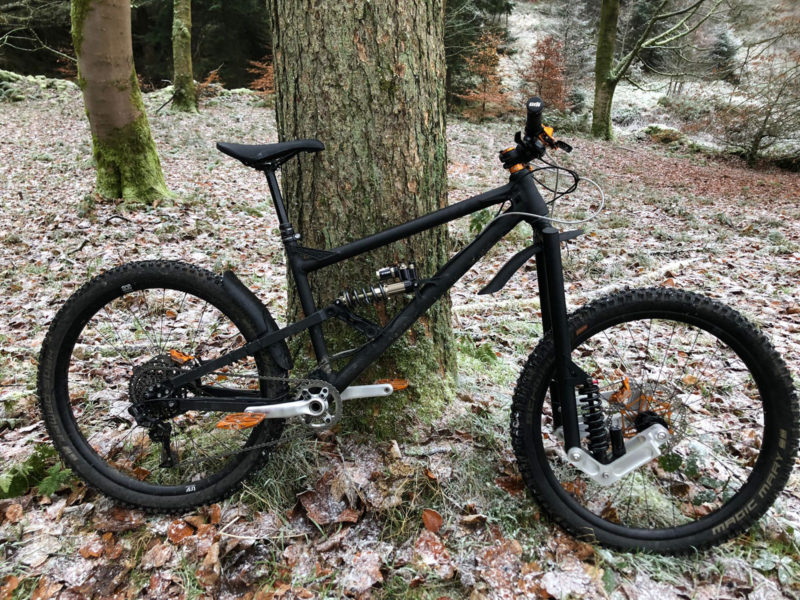
“It never really made sense to me as to why you would tie the chassis, shock, and damper into a single structure. Any force that is put on the structure will in turn have an effect on the damper”, explains Ashley. He’s not the first to have had thoughts along these lines. Motion-France, Adroit and Structure Cycle Works are some more recent examples of brands looking to overcome aforementioned biding issues suffered by the bushings in a telescopic fork under flex, as well as some other characteristics they see as detrimental to performance.
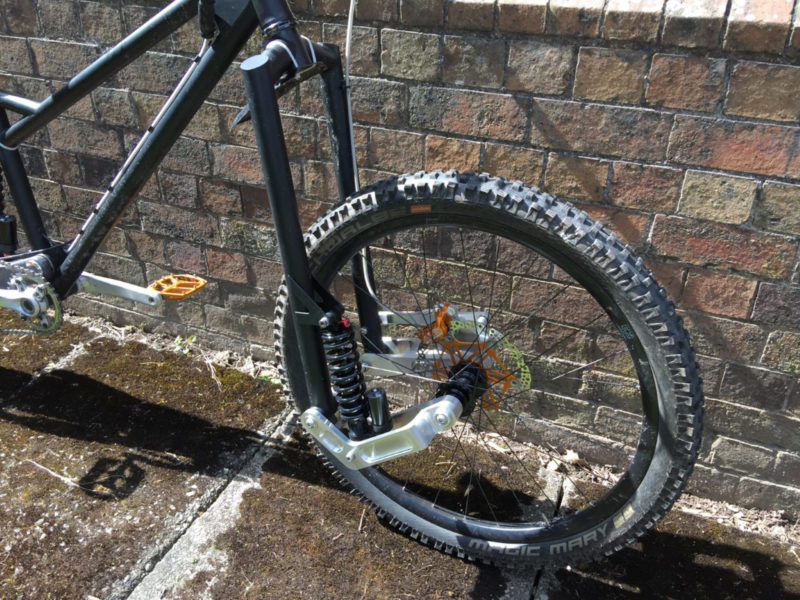
While Motion and Trust developed proprietary dampers for their linkage forks, Adroit and Structure’s designs use off-the-shelf air shocks and thus benefit from their wide range of external adjustments. Ashley felt it made a lot of sense to use a design that could use pretty much any rear shock on the market; get the dimensions correct and the leverage curve sensible, and the fork’s behavior could, in many ways, be as tuneable as the variety of rear shocks available.
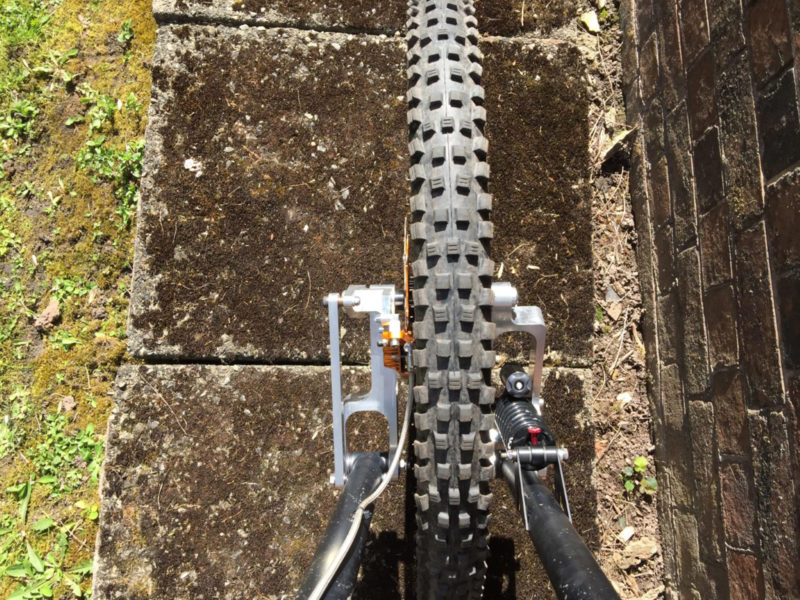
All of the aforementioned are significantly more complicated than Ashley’s single-pivot leading linkage fork, utilizing multiple pivots. The first iteration of the Rock Sled (not shown) was single-sided with a one-piece carbon steerer and carbon leg. It had a single link and a shock absorber delivering 160mm of travel. That was a bare-bones, proof-of-concept prototype.
In the V1, the brake caliper was bolted directly onto the link. Ash tells us the anti-dive force was massive. “Riding along, if you braked with any sort of force, the suspension would want to extend a lot, unless you had a lot of weight over the front. It was really quite violent”. Apart from the anti-dive, Ash says the fork felt stiff enough while riding, and that it didn’t really feel any different from a regular fork.
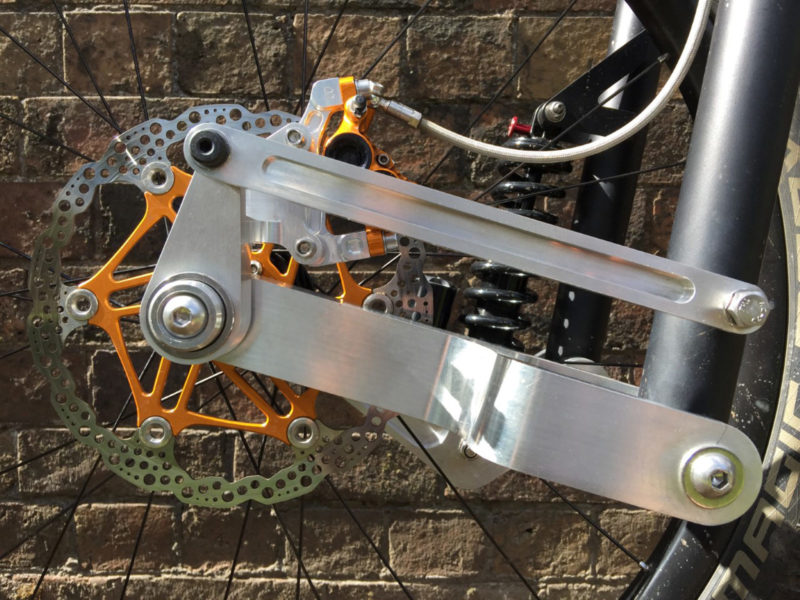
With the second prototype, seen throughout this article, Ash sought to solve the aforementioned braking issue by mounting the brake caliper to a floating brake arm. It takes on a parallelogram arrangement, so when the fork compresses the brake caliper remains equidistant to the fork leg, no matter where in the travel the fork is operating, just as it does in the case of traditional telescopic forks.
So, how does it ride?
“The fork rides like a normal fork in terms of its steering behavior, axle path, and braking behavior. Where it differs is the much greater sensitivity, adjustment, and performance. The use of bearings as the main method of fork movement means that binding and stiction are pretty much non-existent, and being able to swap out the shock for any type that you wish means much greater adjustability. Also, due to there being some very capable shocks available (PUSH, Fast, EXT, etc.) I think the performance in terms of damping can beat any telescopic fork out there. In addition, because the fork has a leverage curve then it can achieve the grail of being sensitive off the top, supportive in the middle, and supportive at bottom out” – Ashley Kalym, Designer of the Rock Sled Fork.
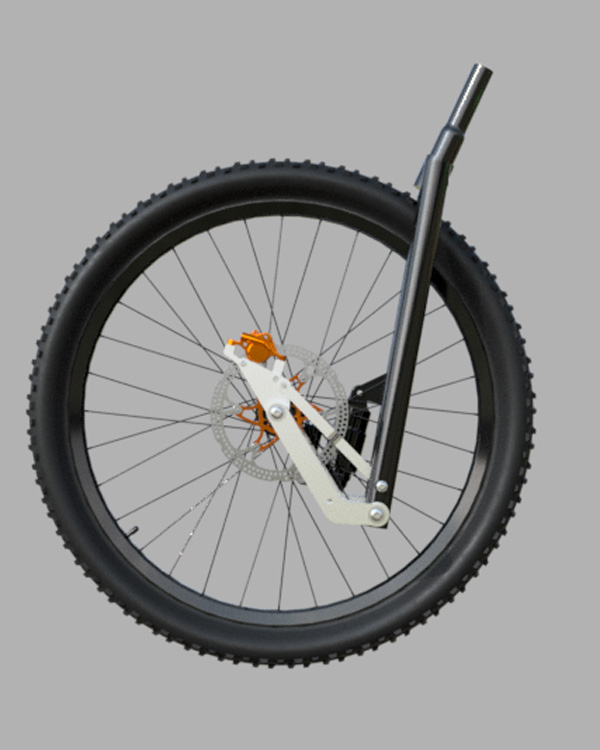
Where the Rock Sled Fork does differ significantly from a telescopic fork, is in ground clearance. As it compresses, the fork legs are pushed down toward the ground. Ashley says that, with a 29″ front wheel, the ground clearance at bottom-out is 209mm (8.22 inches). Despite that, he says he hasn’t found any issues with it on the trail.
Though the head angle delivered by the Rock Sled seems wildly steep upon first glance, it actually comes in at 63° on Ashley’s Nicolai G16 Enduro Bike. With the linkage design, the axle path differs to that of a telescopic fork. Whereas the latter moves in a straight line, following the angle of the steerer tube and thus head angle, the axle of the Rock Sled Fork will track more of a rearward arc as the fork is pushed into compression.
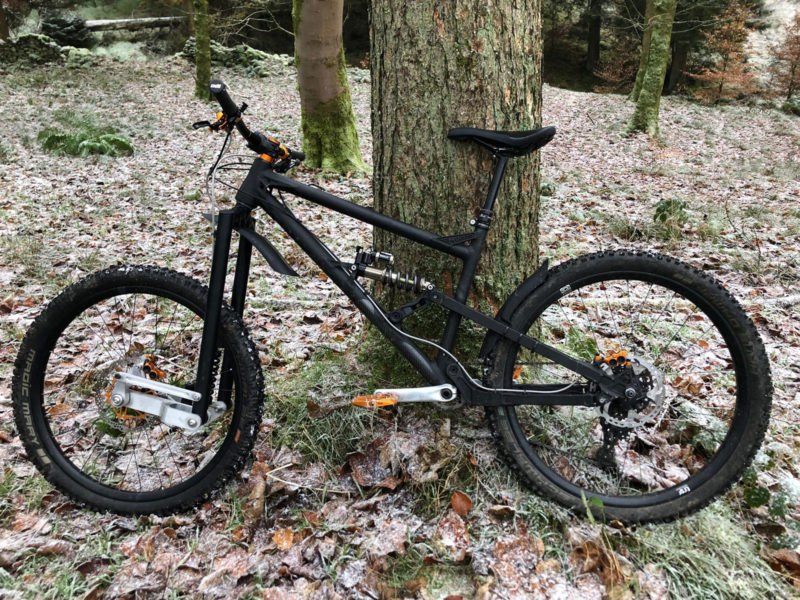
The prototype seen above has a 45mm offset at top-out, decreasing to 17mm at bottom-out. A reduction in offset proportionately increases the bike’s trail figure. Ash says this would, at least on paper, increase your steering stability the deeper into the travel the fork is compressed. A third prototype that was recently 3D Printed, designed for 160mm travel with a 571mm ATC is said to have a more standard axle path with a 51mm offset at top- and bottom-out.
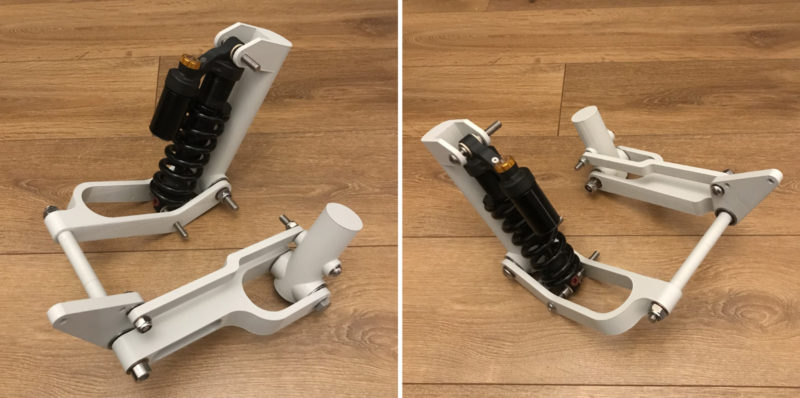
It’s worth pointing out that, even in the Rock Sled Linkage Fork, there will of course still be forces applied to the rear shock outwith the plane in which it provides shock absorption, but Ash has organized the linkage in such a way that, at least in theory, those forces should be greatly reduced in comparison to those experienced on a telescopic fork.
The distance between the pivot and the fork’s 20mm axle is only about 200mm. Ash says the leverage that can be exerted over that distance is quite small. Comparing that to a rear suspension linkage, that distance is considerably less than half the distance between the rear wheel axle and any main pivot on the front triangle.
The latest design of the Rock Sled fork also makes use of a 15mm axle, mainly to more easily serve the market as most trail and enduro riders will have a Boost front wheel (15mm x 110mm). The ambition with this version was to reduce the number of unique parts, simplifying the design from a manufacturing perspective. The left link that does not drive the shock is now the exact same part as the right link that does. This is basically reducing the costs of the CNC machining. Ashley has also reduced the footprint of the fork, bringing the width to <200mm, closer to that of a conventional fork.
What are the next steps for Rock Sled?
If happy with the ride feel of Version 3, Ashley will send the Rock Sled Fork off to EFBE for testing, prior to producing a limited run of forks for sale. He is looking to keep the price as low as possible, in order to enable the greatest number of people to try it out. And, the less money the customer spends on the fork, the more they have left to spend on a high-end shock. Ashley tells us he has deliberately kept things simple in terms of construction, bearings, nuts, and bolts, etc., so as to make the manufacture as cheap as possible, and therefore the retail price as cheap as possible. “I want to aim for under £1,000/$1,000, but how much under this price point it will be I don’t know”.
You can keep up to date with Ash and Rock Sled Suspension on Instagram @rocksled_suspension and @rocksled_bikes
